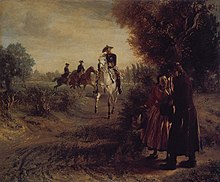Condé (horse)
| Condé | |
 Ludwig Wolf , Condé, 1798 |
|
| Father: | |
| Mother: | |
| Mother, father: | |
| Gender: | gelding |
| Year of birth: | 1766 |
| Year of death: | 1804 |
| Country: | Prussia |
| Colour: | Fly mold |
| Owner: | Frederick the Great |
| Equestrian: | Frederick the Great |
Condé (* 1766 ; † 1804 ) was the last and best-known body riding horse of Frederick the Great .
Life
The fleabitten - Wallach was the age of eleven in 1777 in England for Frederick Marstall acquired and broken in only in this age of equerry Wetge. After the first ride the king gave him his name. Like many of Frederick's horses, Condé now bore the name of a well-known personality; he was named after Louis II. de Bourbon-Condé and quickly became the king's favorite horse. The animal was kept in the palace gardens in Potsdam and is said to have enjoyed many privileges, including entering the round salon. There are different certificates about the stress on the horse. The beast is mentioned in Theodor Fontane's novel Before the Storm , and the description based on a report by Friedrich August Ludwig von der Marwitz gives the impression that the king rode it daily. A report about the inaugural visit of the later reader Friedrich, Girolamo Lucchesini, shows that there was a close familiarity between horse and rider :
- The almost seventy-year-old has been crouching on his body horse "Condé" for hours without Lucchesini having had an opportunity to greet the king ... Now the king is finally dismounting. [...] During the conversation, the "Condé" always trots after the king and sniffs his coat pockets, from which the horse pulls melon slices and figs. The king won't let himself be disturbed ...
Budras / Berg, on the other hand, claim that the horse was only used occasionally and led a rather peaceful life. Indeed, the wear and tear on the skeleton and teeth suggest that Condé was not overloaded; however, the nasal bone shows traces of a tight strap and probably also frequent rein.
The last ride of Frederick the Great on Condé took place on July 4, 1786; a few weeks later the king died. Condé was initially housed in the Neustadt / Dosse stud and in 1790 in the Royal Veterinary School in Berlin . There he died at the age of 38, which is unusually high for a horse.
preparations
His skin was prepared and stuffed and stored together with the blue velvet crockery that Condé had worn during his lifetime in the Langhans domed building, which later belonged to the Berlin University of Veterinary Medicine. The preparation was later exhibited in the Hohenzollern Museum, from which the German Historical Museum emerged. After it had suffered a lot from willful damage by visitors, it was destroyed by an air mine in World War II.
Condé's skeleton was also prepared and exhibited in the Langhans domed building. In 1838, the anatomy professor Ernst Friedrich Gurlt wrote a description of the skeleton. In 1902 the Anatomical Museum and with it Condé's skeleton were housed in the Veterinary Anatomy. At this point in time it was given an oval enamel plaque on which Condé's role as Friedrich's riding horse is mentioned. Today the skeleton is part of the collection of the Free University of Berlin and is in the anatomical museum of the Institute for Veterinary Anatomy in Dahlem.
Condé's incisors were all still present at the time of his death and not completely worn off. The chewing surface of the molars also does not show the expected total abrasion. Apparently the gelding was fed with roughage relatively rarely . With the exception of the damage to the nasal bone already mentioned, the bones themselves do not show any signs of wear that would be typical for such an old horse.
Condé in literature and art
As already mentioned, Condé found its way into a novel by Theodor Fontane. A painting by A. Niegelsjahr from 1797 shows him in front of the Langhans building. The German Horse Museum in Verden an der Aller has a copper engraving by Ludwig Wolf from 1798 entitled Condé. Body riding horse Sr. Most Holy Majesty Frederick the One. 30 years old. wearing. The mold in the painting Petition by Adolph von Menzel is probably also a representation of Condé. The purchase of the painting was initially rejected by the Prussian court because of the un-royal muddy path on which Frederick the Great rides. However, Wilhelm II bought it in 1912 and it hung in Hechingen Castle until it was auctioned in 2007 . When creating the equestrian statue of Frederick the Great, Christian Daniel Rauch also followed the templates of his predecessors.
Web links
Individual evidence
- ^ Mention of Condé by Friedrich August Ludwig von der Marwitz
- ↑ Joachim von Kürenberg, The last confidante of Frederick the Great, Marchese Lucchesini , Berlin 1933, p. 35 f., Quoted from: Sibylle Princess of Prussia and Friedrich Wilhelm Prince of Prussia, Die Liebe des König. Friedrich the Great, his wind chimes and other passions , Munich 2006, p. 141 f.
- ^ "Condé" - the last personal riding horse of Friedrich II of Prussia as a witness of the history of Prussia and veterinary medicine in Berlin ( memento of the original from August 20, 2007 in the Internet Archive ) Info: The archive link was automatically inserted and not yet checked. Please check the original and archive link according to the instructions and then remove this notice.
- ^ Horse stories from a veterinarian from Machern in Saxony
- ↑ Article on the website of the German Horse Museum ( Memento from April 30, 2011 in the Internet Archive )
- ↑ Menzel paints the king on the FAZ website



